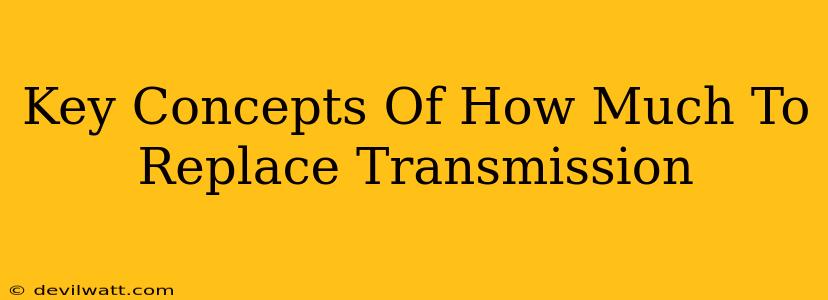Replacing a transmission is a significant automotive repair, and understanding the cost is crucial before you even consider taking your vehicle to a mechanic. This guide breaks down the key concepts influencing the price of a transmission replacement, so you're prepared for what to expect.
Factors Affecting Transmission Replacement Cost
Several interconnected factors significantly impact the final bill for a transmission replacement. Let's explore them in detail:
1. The Type of Transmission:
- Automatic vs. Manual: Automatic transmissions are generally more complex and expensive to replace than manual transmissions. This complexity translates to higher labor costs and potentially more expensive parts.
- Transmission Type: The specific type of automatic transmission (e.g., CVT, dual-clutch, traditional torque converter) also plays a role. More advanced transmissions typically command higher replacement costs.
2. Vehicle Make and Model:
- Luxury vs. Economy: Replacing the transmission in a luxury vehicle will almost always be more expensive than in an economy car. This is due to higher-priced parts and potentially more specialized labor requirements.
- Year and Model: Older vehicles may have more readily available used parts, potentially lowering the overall cost. However, newer vehicles might require specialized tools and expertise, leading to higher costs.
3. Labor Costs:
- Mechanic's Hourly Rate: The hourly rate charged by the mechanic or repair shop will greatly influence the labor portion of the bill. Independent shops often have lower rates than dealerships.
- Complexity of the Repair: Some vehicles require more extensive labor to access and replace the transmission. This can increase the overall labor time and, consequently, the cost.
4. Parts Costs:
- New vs. Used/Rebuilt: A new transmission is the most expensive option, while a used or rebuilt transmission can significantly reduce costs. However, used and rebuilt transmissions carry a degree of risk. You must carefully weigh the potential cost savings against the potential for premature failure.
- Parts Availability: The availability of parts for your specific vehicle also impacts pricing. Some parts may be difficult to source, resulting in higher costs and longer wait times.
5. Additional Repairs:
- Related Issues: Often, transmission problems aren't isolated. A failing transmission might have damaged other components, requiring additional repairs. These additional repairs, such as replacing the torque converter or driveshaft, add to the total cost.
- Fluid and Filter Changes: A complete transmission replacement usually involves replacing the transmission fluid and filter, adding to the overall expenditure.
Getting the Best Price for Transmission Replacement
- Shop Around: Obtain multiple quotes from different repair shops and dealerships to compare pricing and services.
- Ask Questions: Don't hesitate to inquire about the type of transmission being used (new, used, or rebuilt), the warranty offered, and the labor rates.
- Check Reviews: Read online reviews of local repair shops to assess their reputation and customer service.
- Negotiate: Once you have multiple quotes, consider negotiating with repair shops to potentially secure a more favorable price.
Understanding the Total Cost
The total cost of a transmission replacement can range from a few thousand dollars to well over ten thousand, depending on the factors discussed above. A clear understanding of these factors will empower you to make informed decisions about your vehicle repair and help you avoid unexpected costs. Remember to always get a detailed estimate before authorizing any work.

